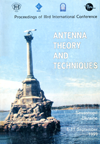Coherence-reduced signal processing in large arrays
DOI:
https://doi.org/10.1109/ICATT.1999.1236169Abstract
Long-range (electromagnetic, acoustic) signal propagation in random-inhomogeneous environments is well known to lead to loss of the signal coherence in space, time and frequency, which results from stochastic effects of multiple signal scattering. From an application point of view in radar and sonar, an important issue is to optimize the signal processing techniques and, therefore, to decrease in part or even to minimize a coherence-induced degradation of the processor performances.
Following the general idea of spatial-temporal processing factorization, we restrict ourselves to the study of coherence effects in the spatial domain, which is of primary interest in large-array beam-forming. The problem of array processing under the conditions of reduced signal coherence was studied earlier by several authors [1-4] on the basis of a general theory of random signal detection [5] but without invoking specific models for the channels of propagation. In our recent papers [6, 7] we developed an effective approach of combined consideration of the signal coherence and array signal processing for long-range sound propagation in underwater sound channels. A distinctive feature of this study is incorporating realistic models of the signal coherence to predict the coherence effects on the array beam-pattern and gain for several types of linear and quadratic array processors, the optimal ones included. In the comparative analysis of array processors, we exploit, as a basic technique, the eigenvalue-eigenvector decomposition of the signal covariance matrices. Generally, this approach can be effectively used for various detection criteria including the maximum likelihood (ML) and maximum signal-to-noise (SNR) ones. Our particular interest concerns the small-signal asymptotics of the ML detection performance, which is a reasonable choice for long-range signal reception against the noise background.
In this paper, we give a short introduction to large-array processing of partially coherent, or spatially random signals with emphasis on optimal linear and quadratic beamformers.
References
Cox, H. J. Acoust. Soc. Amer., 1973, Vol. 54, p. 1743-1746.
Morgan, D.R.; Smith, T.M. J. Acoust. Soc. Amer., 1990, Vol. 87, p. 737-747.
Laval, L.; Labasque, Y. Underwater Acoustics and Signal Processing. Dordrecht, The Neth-erlands: D. Reidel, 1981 [ed. by L. Bjorno], pp. 41-70.
Malekhanov, A.I.; Talanov, V.I. Sov. Phys. Acoust., 1990, Vol. 36, p. 496-499.
Van Trees, H.L. Detection, Estimation and Modulation Theory, Part I. New York: Wiley, 1968.
Gorodetskaya, E.Yu.; Malekhanov, A.I.; Talanov, V.I. Sov. Phys. Acoust., 1992, Vol. 38, p. 571-575.
Gorodetskaya, E.Yu.; Malekhanov, A.I.; Sazontov, A.G.; Vdovicheva, N.K. IEEE J. of Ocean Eng., 1999, Vol. 24 (in press).
Shirman, Ya.D.; Manzhos, V.N. Theory and Techniques of Signal Processing in Radar. Moscow: Radio i Svyaz', 1981 [in Russian].
Monzingo, R.A.; Miller, T.W. Introduction to Adaptive Arrays. New York: Wiley, 1980.
Shifrin, Ya.S. Radiotekhn. i Electron., 1990, Vol. 35, p. 1345-1360.

